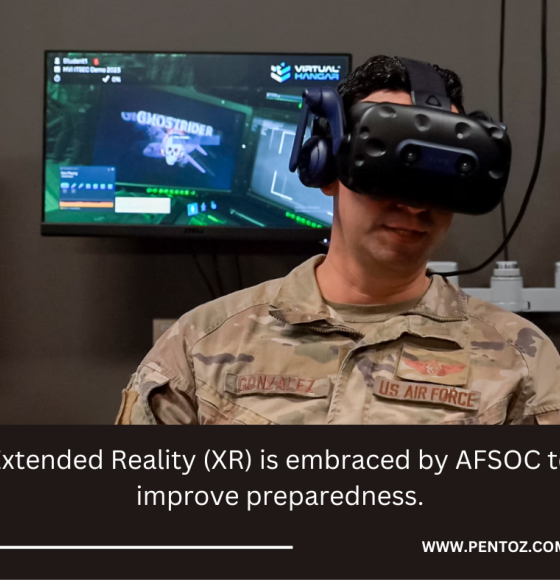The approach to training and preparation taken by Air Force Special Operations Command is being revolutionized through Extended Reality (XR). Virtual Reality (VR), Augmented Reality (AR), and Mixed Reality (MR) are all included under the umbrella term “XR,” which allows for the creation of a variety of experiences, from completely virtual settings to the superimposition of digital content on the actual world. Because of how these technologies affect our view of reality, they are considered “extended.” At its core, XR involves the alteration of reality, and it is changing the AFSOC training environment.
Through secure, autonomous learning distribution and reporting across all command disciplines, the XR Training Program’s goal is to give Air Commandos the capacity to conduct recurrent preparedness training anywhere, at any time. The goal is to create a training program that uses virtual, mixed, and augmented learning techniques to produce warfighters with larger skill sets and proficiency in a more realistic setting at a lower cost and faster turnaround.
AFSOC developed a cross-functional XR team at the start of FY23 with the goal of developing an XR Training Framework for the entire command.
Capt. Kyle Schoonover, Chief of the AFSOC XR Training Program, stated that the first thing the command did was acknowledge that it had lagged behind in the development of training technologies. “In true AFSOC fashion, we went from this realization to producing a MAJCOM-wide framework capable of incorporating all existing XR technologies and charting a course for future development in the years to come in just a few months,” the author said.
This architecture, which consists of four different lines of effort (LOEs), operates on a crawl, walk, run method:
LOE 1: Virtual Hangar:
The first qualifying academic training for all aircrew support and mission support employees, including maintenance and Mission Sustainment Teams, is the core emphasis of the foundational effort for XR in AFSOC. The AFSOC A4 project “Virtual Hangar” is a shining illustration of this. This ground-breaking effort uses virtual reality to improve the workforce training for the AC-130J, MC-130J, CV-22, and ammunition maintenance. The “Virtual Hangar” provides thorough Instructor Tools and specifically designed Learning Modules, ranging from checklist execution to 3D-modeled schematic overlays.
LOE 2: NexGen Instructor:
All Flying Training Units (FTUs) that train AFSOC aircrew will adopt VR, according to AFSOC. The academic components of the FTU curriculum, such as academics on aircraft systems and mission equipment, will be covered by training modules. When appropriate, collaborative alliances with other Major Commands (MAJCOMs) will be pursued, and pathfinding will frequently be necessary.
LOE 3: Fusion & Integration:
A key component of AFSOC’s strategy is the integration of XR into operational units, with a focus on mission events. These activities can include simulating the flight of an AFSOC aircraft, using particular techniques, or involving our medical community throughout the whole spectrum of patient care.
LOE 4: The Future Fight
The ultimate goal of AFSOC’s XR Training Framework is the use of Augmented Reality (AR) by aircrew and special operations forces. Imagine a pilot of a CV-22 aircraft flying over the Melrose Air Force Range in New Mexico while viewing real-world terrain from far-off regions like the Indo-Pacific. In the meantime, a digital wingman operated by a ground-based XR device is visible in the pilot’s visor. The objective is to use XR technology to recreate any battlespace back at the home station.
According to Schoonover, “AFSOC’s XR framework gives every unit in the command an easily understandable and repeatable strategy to modernize their training through next-generation methodologies of instruction.”
The AFSOC XR Training Framework is currently being implemented. While AFSOC personnel continue to work through LOE 1 by immersing themselves in virtual reality and “Virtual Hangars,” LOE 2 is looming with small group XR testing sessions with the AC-130J FTU and the C-146 FTU scheduled for Summer 2024 and Fall 2024, respectively. The line of activities will pick up steam as funding for the framework of the training program is maintained.
Lt. Gen. Tony Bauernfeind, commander of AFSOC, stated that the organization “is heavily invested in enhancing readiness and training through initiatives like XR.” “Air Commandos may experience extremely lifelike simulations of difficult events, missions, and environments they might run into in actual operations thanks to the usage of XR in training. As we get ready for the operating conditions of the present and the future, this practice is crucial. I’m interested to watch where this program goes, and if funding becomes available, we will be prepared to expand on each area of focus.
AFSOC is preparing to alter its training methodology and ensure that Air Commandos are better equipped and prepared for strategic competition now that a thorough XR Training Framework is in place.

















